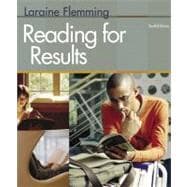
Note: Supplemental materials are not guaranteed with Rental or Used book purchases.
Purchase Benefits
| Strategies for Mastering Your Textbooks Introducing SQ3R | |
| Survey, Question, Read, Recite, Review S | |
| Survey to Get a General Overview Q | |
| Use Questions to Guide Your Attention R | |
| Read R: Recite R | |
| Review Mining the Web for Background Knowledge Introducing Bonus Questions Sample Chapter | |
| The Cold War Abroad and at Home, 1945-1952 | |
| Word Power Using Context Context and Meaning Defining Words from Their Parts Combine Forces | |
| Use Context Clues and Word Parts More Pointers About Specialized Vocabulary Connotations and Denotations of Words The Difference Between Reading and Writing Vocabularies | |
| Relating the General to the Specific in Reading and Writing General and Specific Words | |
| Understanding the Difference Between General and Specific Sentences | |
| The Writer's Responsibility | |
| The Reader's Response Connecting General and Specific Sentences in Paragraphs | |
| Discovering Topics, Main Ideas, and Topic Sentences | |
| Identify the Topic Use the Topic to Discover the Main Idea | |
| Topic Sentences and Main Ideas More | |
| Topic Sentence | |
| Locations Paraphrasing Topic Sentences | |
| A Two-Step Method for Paraphrasing Complex Ideas | |
| Inferences and Main Ideas | |
| Inferences in Everyday Life Filling in the Gaps in Topic Sentences | |
| Inferring Main Ideas | |
| Five Types of Paragraphs Likely to Imply the Main Idea More on Evaluating Your Inferences | |
| Test 6 Vocabulary Review | |
| More on the Function of Supporting Details | |
| Supporting Details Develop | |
| Topic Sentences Understanding the Difference Between Major and Minor Details | |
| Topic Sentences Help Identify Major Details Transitions and Major Details Reader-Supplied Inferences and Supporting Details Visual Aids as Supporting Details | |
| Concluding Sentences and Supporting Details | |
| Beyond the Paragraph: Reading Longer Selections | |
| Moving Beyond the Paragraph Diagramming | |
| Major and Minor Details | |
| Implied Main Ideas in Longer Readings | |
| Monitoring Comprehension with Informal Outlines | |
| Taking Notes with Informal Outlines Introducing Graphic Organizers | |
| Recognizing Patterns of Organization in Paragraphs | |
| Definition | |
| Time Order | |
| Comparison and Contrast | |
| Cause and Effect | |
| Classification Identifying the "Primary" Pattern | |
| Combining Patterns in Paragraphs and Longer Readings | |
| Combining Patterns in Paragraphs Seeing Patterns in Longer Readings | |
| More on Purpose, Tone, and Bias Why Think About Purpose? | |
| Informative Writing | |
| Persuasive writing Separating Fact and Opinion | |
| Combining Opinions with Facts Evaluating Bias in Persuasive Writing | |
| Backing Opinions with Arguments Putting It All Together Reading | |
| The Altruistic Personality | |
| Reading | |
| A Hero Scorned, USA Today Editorial | |
| Reading | |
| Does America Need a Third Party? | |
| Reading | |
| The Stereotype Trap | |
| Reading | |
| Where Does Free Speech End? | |
| Reading | |
| Memory, Perception, and Eyewitness Testimony | |
| Reading | |
| Kohlberg's Six Stages of Moral Judgment | |
| Reading | |
| Marla Ruzicka: An Activist Angel | |
| Reading | |
| The Wolf Children | |
| Reading | |
| Nuclear Power and Waste Disposal | |
| Appendix: Reading Pie Charts and Graphs | |
| Table of Contents provided by Publisher. All Rights Reserved. |
The New copy of this book will include any supplemental materials advertised. Please check the title of the book to determine if it should include any access cards, study guides, lab manuals, CDs, etc.
The Used, Rental and eBook copies of this book are not guaranteed to include any supplemental materials. Typically, only the book itself is included. This is true even if the title states it includes any access cards, study guides, lab manuals, CDs, etc.